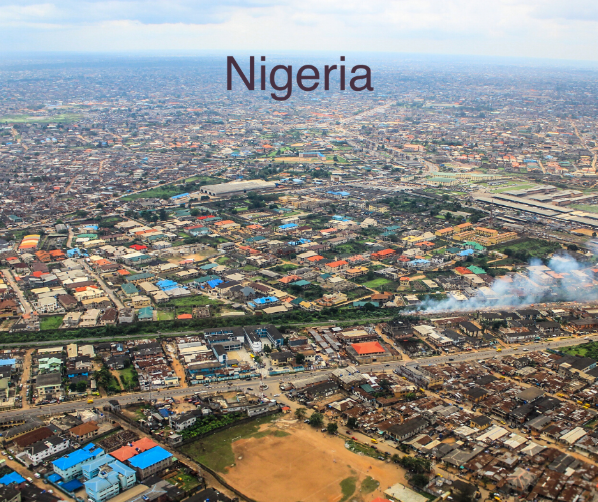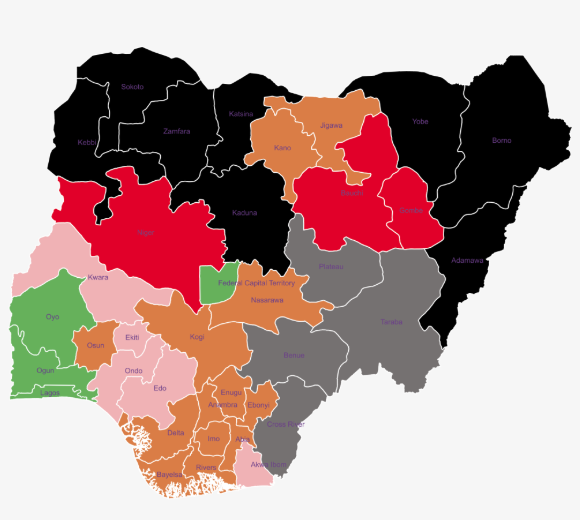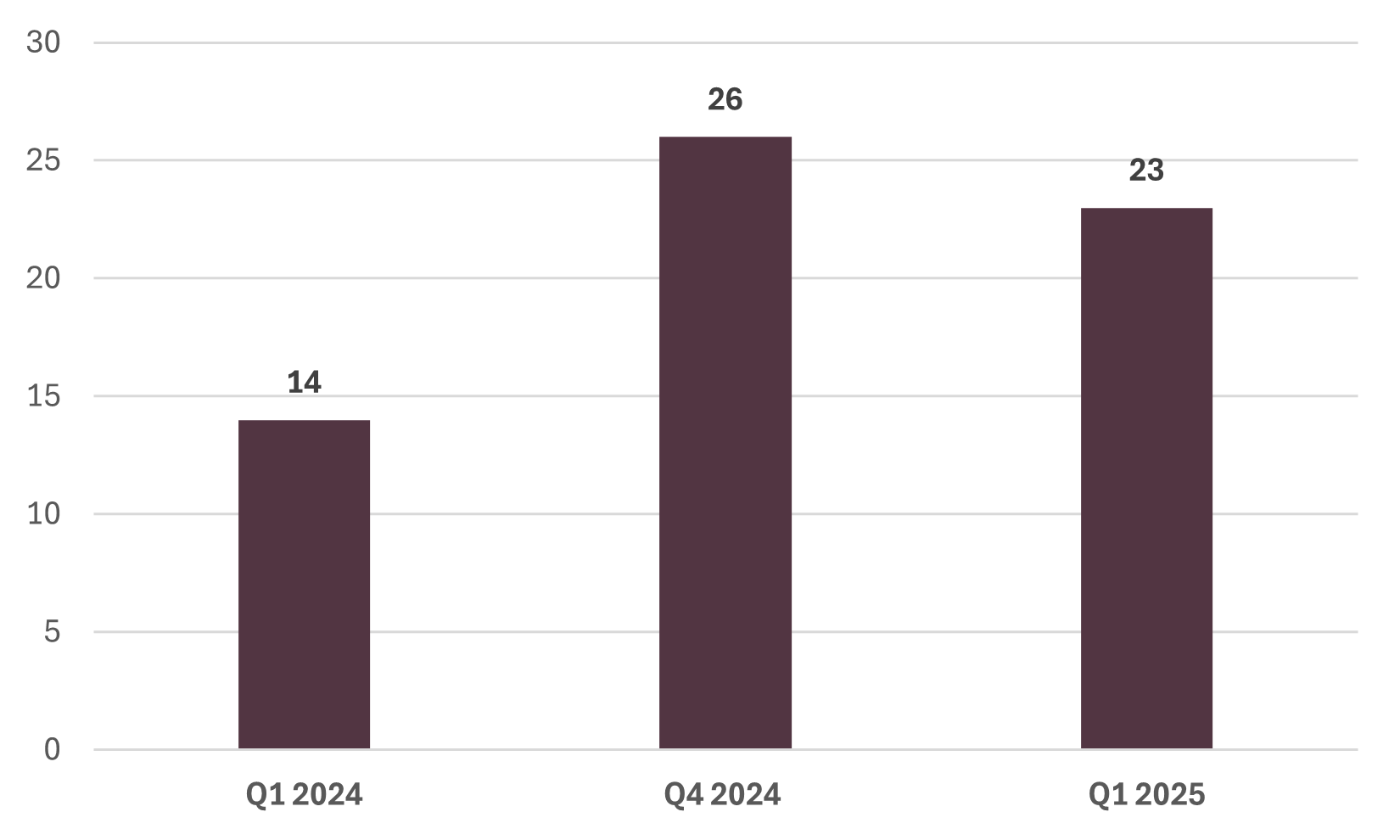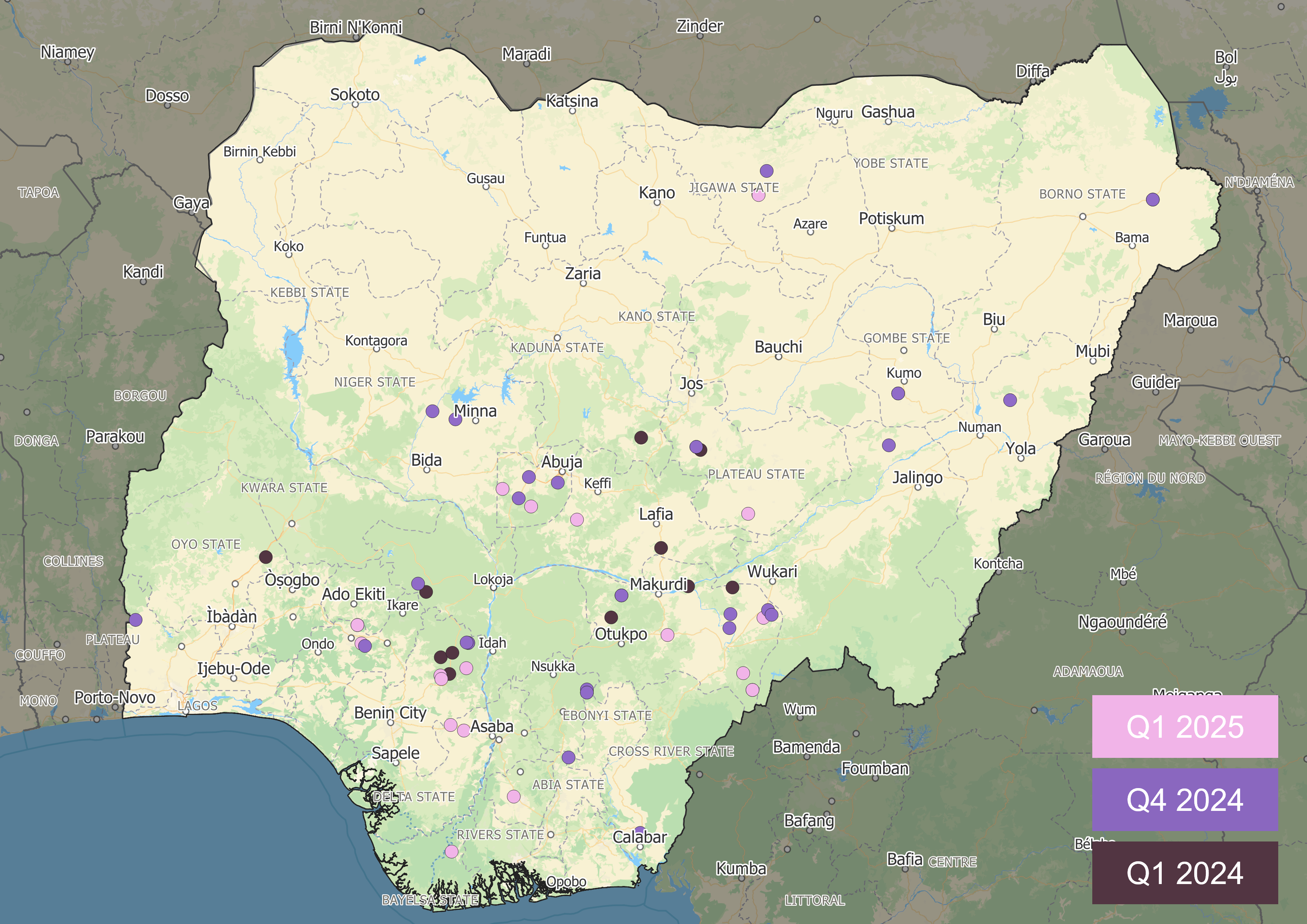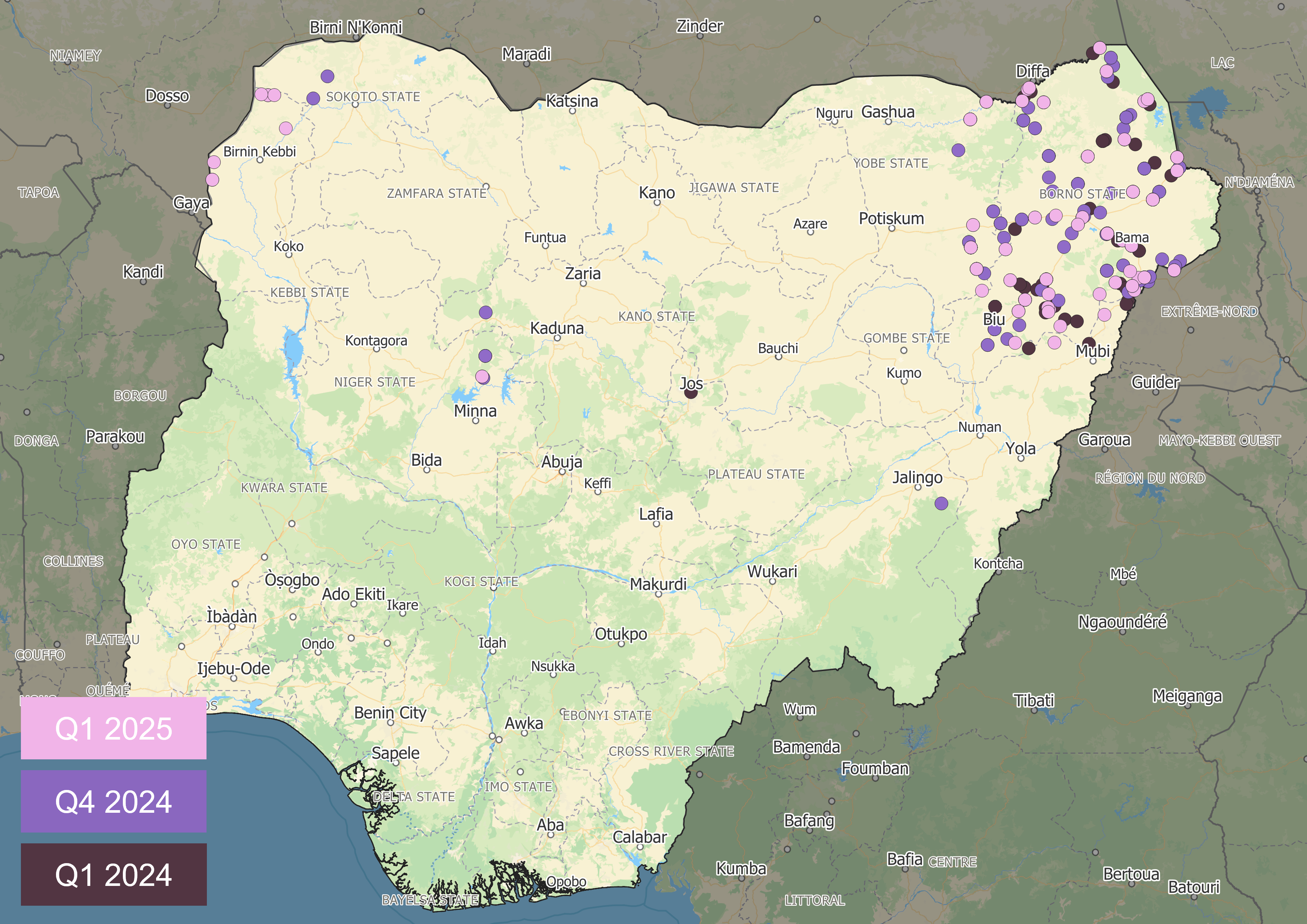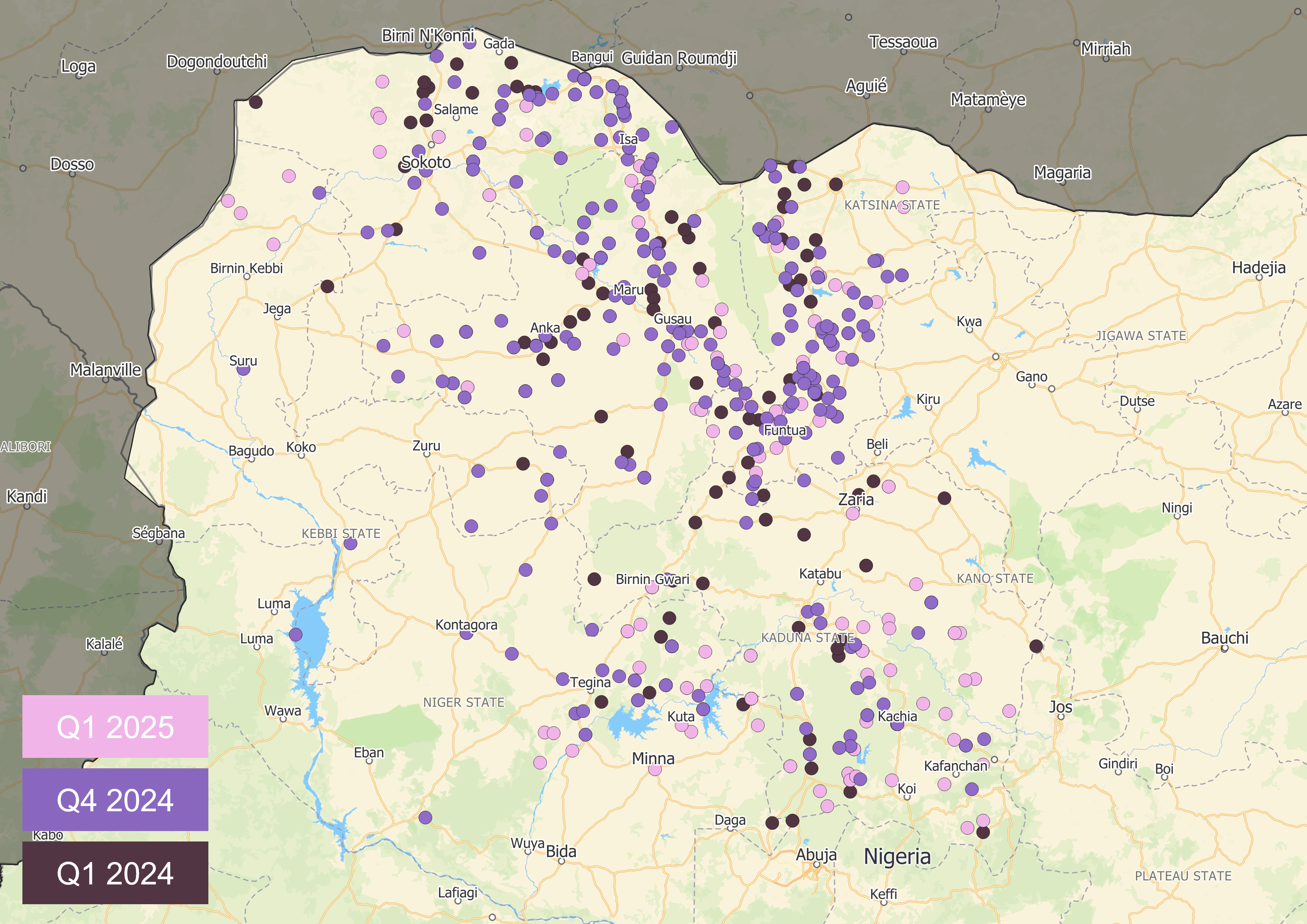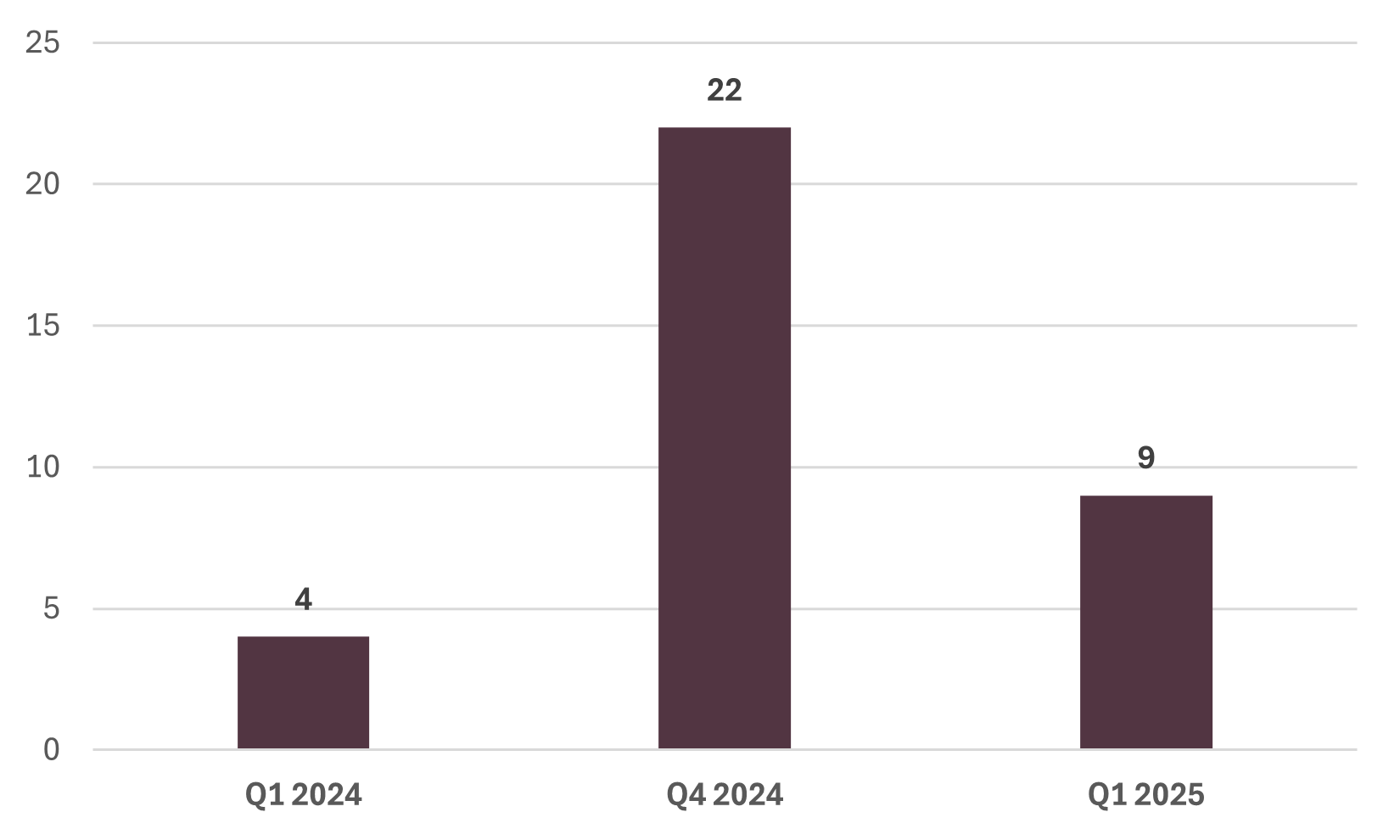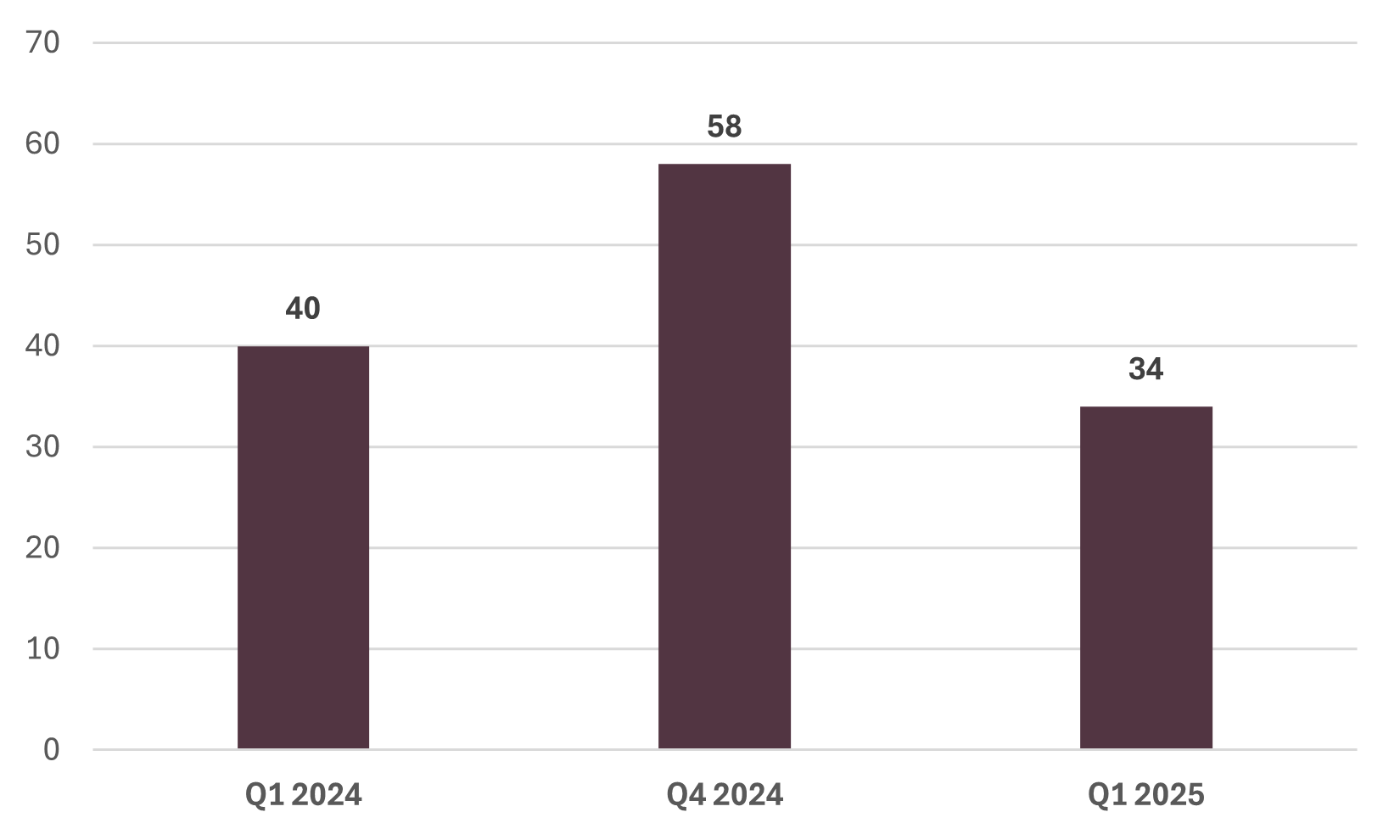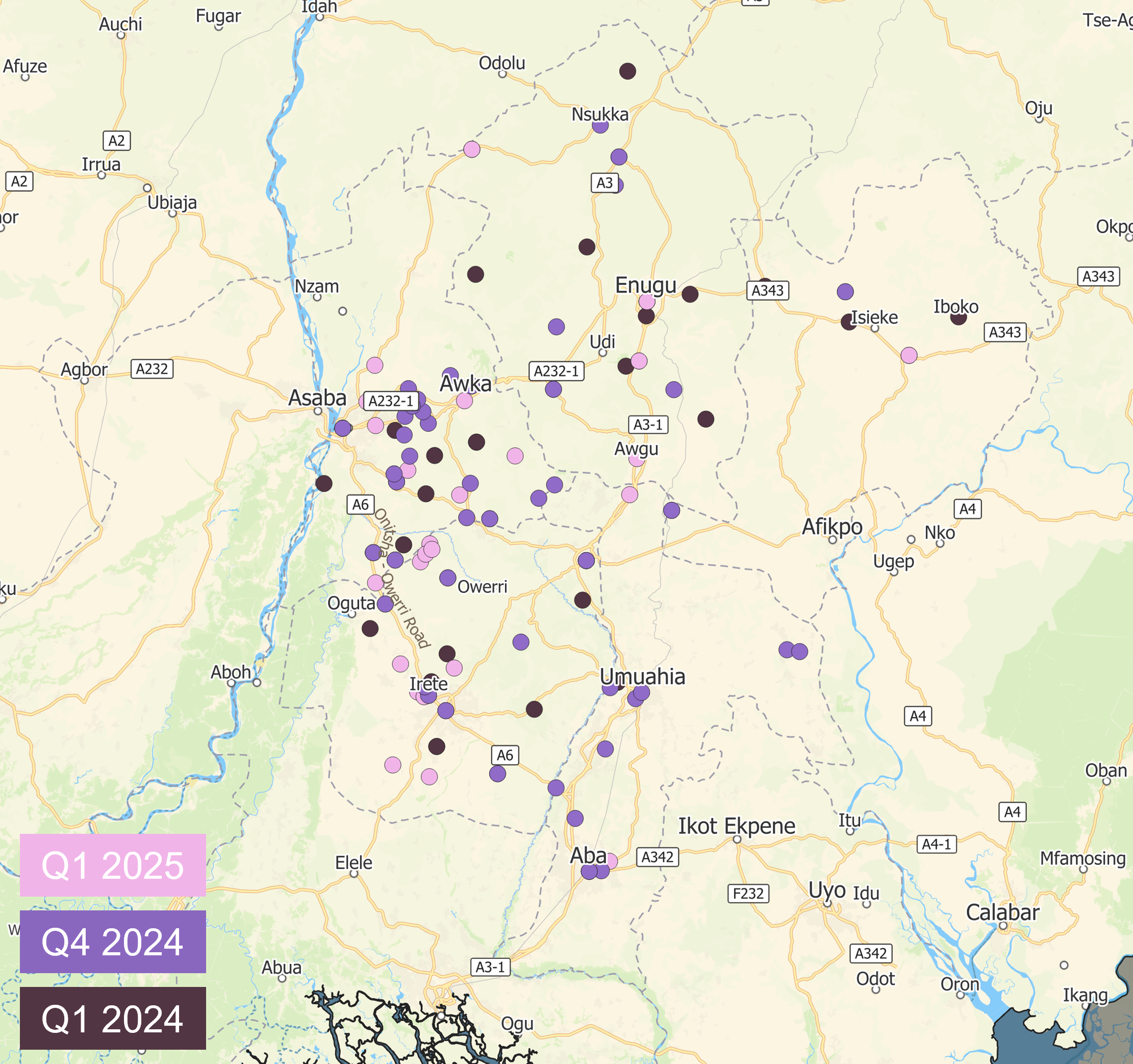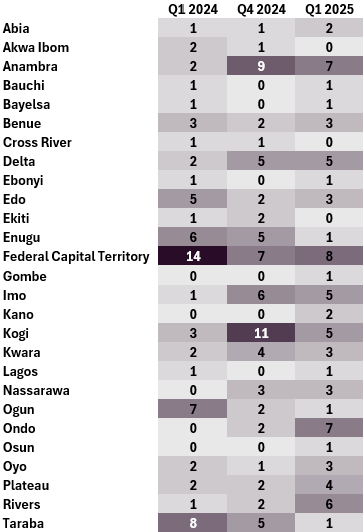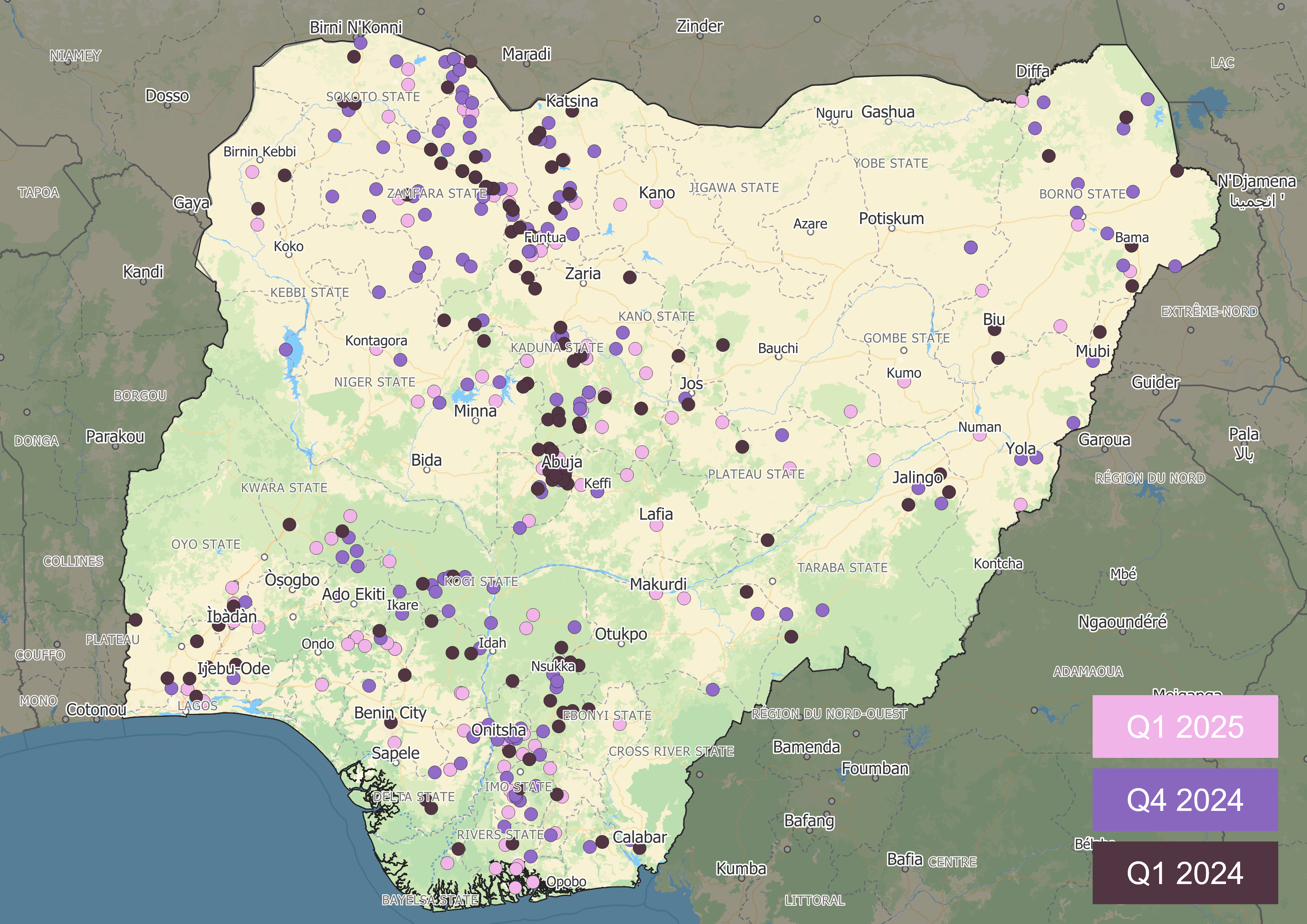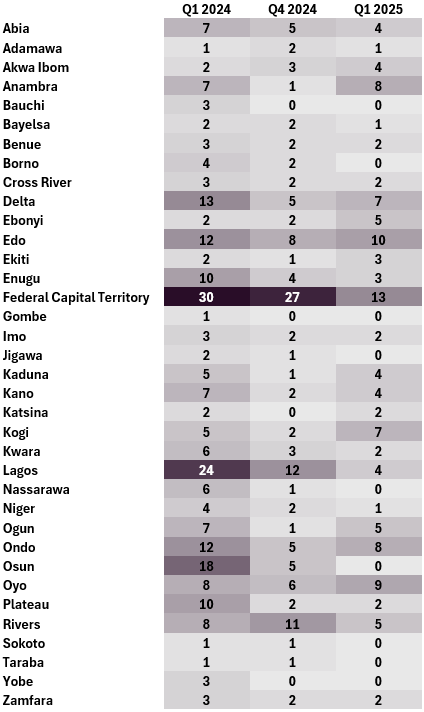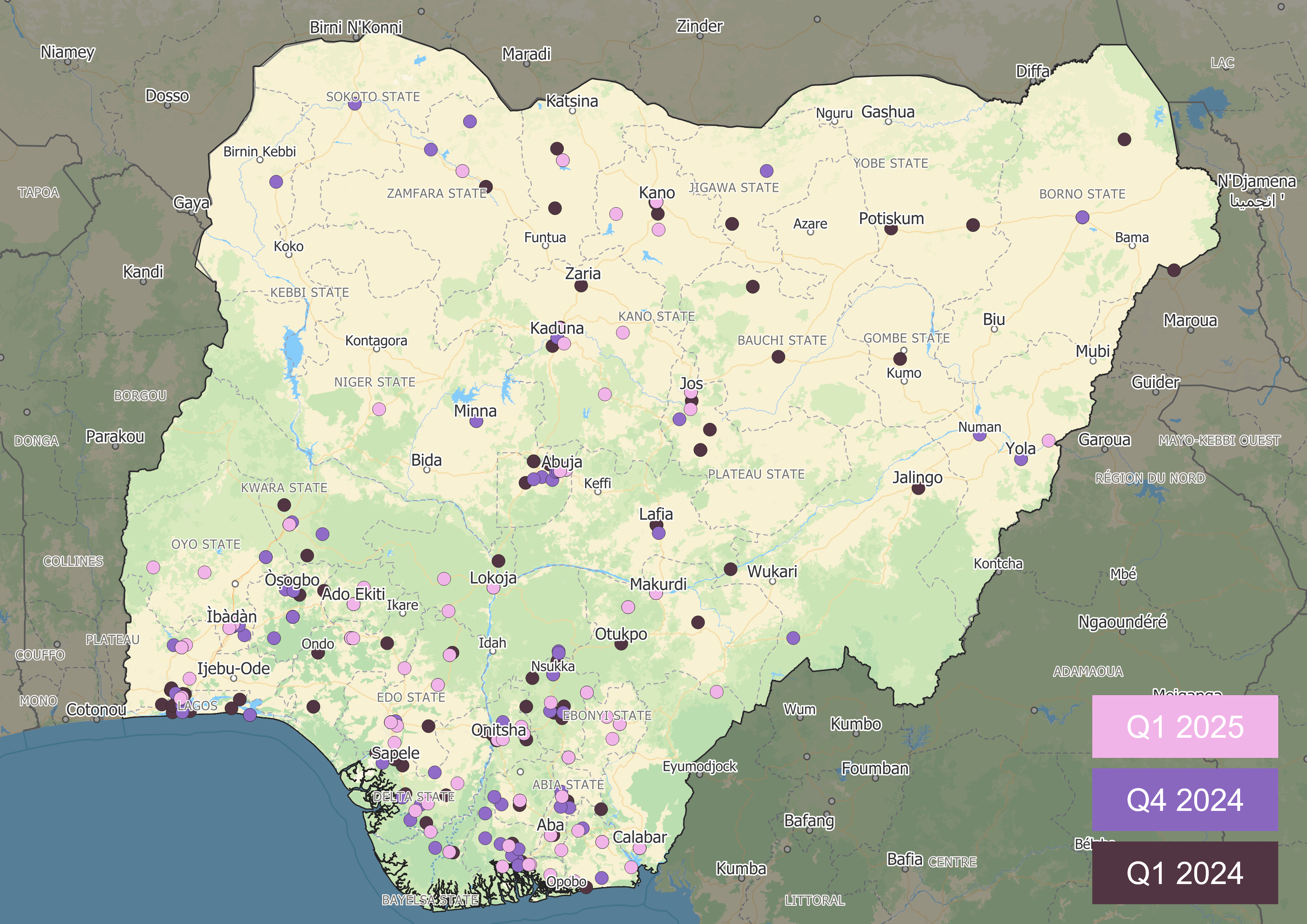Quarterly Report Thursday 24 April 2025 |
Reporting period is from Wednesday 01 January to Monday 31 March |
Dear Client, Please find below our most recent Nigeria Quarterly Report. If you have any queries about our reports please contact us at africaops@castorvali.com. |
- Farmer-Herder Crisis: Farmer-herder violence rose 64 per cent in Q1 2025 year-on-year, with incidents expanding beyond the Middle Belt into Ondo, Edo, Delta, Imo, Bayelsa, and Benue, despite a quarterly decline.
- Farmer-herder violence will likely persist in the Middle Belt, with rising attacks in Edo, Delta, and Ondo. Growing fatalities and misinformation are fuelling instability, panic, and inter-ethnic tensions in southern Nigeria.
- Terrorism: Terrorist attacks dropped sharply in Q1 2025, but fatalities rose due to Islamic State West Africa Province (ISWAP) and Boko Haram. ISWAP's drone use and Islamic State Sahel Province’s (ISSP) activity in Kebbi highlight growing militant capabilities.
- Islamist militancy will remain concentrated in the North East in Q2 2025. ISSP’s cross-border activity threatens parts of Kebbi and Sokoto, while ISWAP’s drone use underscores rising tactical risks and weak countermeasures nationwide.
- Banditry: Bandit attacks dropped 17 per cent year-on-year in Q1 2025, but violence surged in parts of Niger, Kaduna, and Sokoto. Improvised explosive device (IED) use fell sharply, though hotspots like Shiroro and Kauru remain volatile.
- Bandit activity is expected to remain steady in Q2 2025, though escalating violence near Minna and in parts of Kaduna and Sokoto states indicates worsening insecurity and possible regional expansion.
- Separatism: Biafran separatist attacks in the South East surged 125 per cent year-on-year in Q1 2025 but declined from Q4 2024. Violence remained concentrated around Onitsha, Owerri, and Enugu, with rising civilian and police casualties.
- Biafran separatist violence is likely to persist around Onitsha, Owerri, and Enugu, with police stations, civilians—especially ethnic northerners—and roadways facing continued threats from ambushes, IEDs, and armed attacks.
- Kidnapping: Kidnappings remained stable year-on-year in Q1 2025 but declined 14 per cent from Q4 2024. Increases were noted in southern states and key highways, with herder-linked violence fuelling inland abductions.
- The kidnapping threat is set to stay high in the North West and North East. Key highways—including routes near Agbor, Anyigba, Ibadan, and Sagamu—are likely to remain major abduction hotspots in Q2 2025.
- Civil Unrest: Civil unrest dropped nearly 50 per cent year-on-year in Q1 2025. However, protests persisted in several states over local grievances, while political tensions deepened in Rivers, Osun, and Kano amid instability.
- Civil unrest is unlikely to surge in Q2 2025, though unresolved grievances and economic hardship sustain public frustration. In Rivers State, tensions over emergency rule may escalate into political violence and regional spillover.
|
Overall, farmer-herder violence rose by around 64 per cent in the first quarter of 2025 compared to the same period in 2024, but declined by approximately 11 per cent relative to the fourth quarter of 2024. |
Farmer-herder conflict in Nigeria during Q1 2024, Q4 2024 and Q1 2025. Data: ACLED |
Farmer-herder attacks remained largely concentrated in the Middle Belt region; however, notable increases in violence were also recorded in Ondo, Edo, and Delta states. Specifically, incidents rose in Akure North LGA (Ondo), Esan West, Owan West, Etsako East, and Etsako West LGAs (Edo) (see Weekly Report published on 04 March 2025), Aniocha South and Ika North East LGAs (Delta), as well as in Owerri West LGA (Imo), Yenagoa (Bayelsa), and Kwande LGA (Benue). |
Farmer-herder conflict in Nigeria during Q1 2024, Q4 2024 and Q1 2025. Data: ACLED |
Forecast Farmer-herder violence is highly likely to remain a persistent threat in the Middle Belt states of Benue, Nasarawa, Niger, and Plateau over the long term. However, recent herder attacks in Edo, Delta, and Ondo states point to a worsening security situation, particularly along the A232 road east of Agbor in Delta State, the A2 road between Auchi and Ekpoma in Edo State, and in Akure North LGA, where increasing farmer and civilian fatalities, coupled with protests against insecurity, underscore a marked decline in local stability. The 27 March mob attack on a bus in Uromi (see Weekly Report published on 01 April 2025), east of Ekpoma, further highlights elevated public panic, fuelled in part by misinformation and disinformation. Continued herder violence in southern states such as Delta and Edo is likely to strain inter-ethnic relations between communities from the north and south, with false information playing a key role in deepening mistrust and triggering further unrest. |
The number of attacks linked to terrorist groups fell by approximately 100 per cent in Q1 2025 compared to the same period in 2024, and by 36 per cent compared to Q4 2024. However, fatalities attributed to Boko Haram and Islamic State West Africa Province (ISWAP) activity increased by around 40 per cent year-on-year and 38 per cent compared to Q4 2024. As detailed in our last quarterly report, ISWAP executed its first known attack using a modified commercial drone to drop explosives on a forward operating base in Wajiroko, Borno State. In Q1 2025, the group employed drones in at least three additional attacks, highlighting a notable enhancement in their tactical capabilities. In January, MNJTF commander Major General Godwin Mutkut acknowledged a lack of counter-drone technology, including jamming systems, leaving both security forces and civilians exposed to aerial threats. Cameroonian authorities further reported that militants in the Lake Chad Basin are acquiring advanced weaponry and increasing their operational strength. In the North West Region, Islamic State Sahel Province (ISSP), also known locally as Lakurawa, conducted a record eight attacks in Arewa and Argungu LGAs, Kebbi State, despite airstrikes in December 2024 (see Weekly Reports published on 11 February 2025 and 11 March 2025). The group's targets included civilians, customs officials, and telecom workers, indicating a strategy aimed at undermining state authority and disrupting surveillance along Nigeria’s north-western border. |
Islamist militant group activity in Nigeria during Q1 2024, Q4 2024 and Q1 2025. Data: ACLED |
Forecast Terrorism trends are likely to remain largely unchanged in the second quarter of 2025. The North East Region will continue to be the epicentre of Islamist militancy. ISSP's increased activity in the Arewa and Argungu LGAs of Kebbi State is an indication of their strong presence in this area of the Niger-Nigeria border. Nevertheless, the group's attacks on the Nigerien side of the north-western Nigerian border indicate that Dandi LGA in Kebbi State, as well as Illela and Gudu LGAs in Sokoto State, are susceptible to ISSP infiltration and assaults during the second quarter of 2025. Separately, the use of weaponised drones by ISWAP suggests the North East Region will be the theatre most affected by this weapon system during the second quarter of 2025, likely as part of complex attacks. However, while trends surrounding their use do not suggest an imminent threat to areas outside the North East Region, their use also raises concerns surrounding drone countermeasures and the readiness of security forces in other regions, especially around hotels, diplomatic missions, government facilities, and military installations. |
The number of attacks by bandit groups in Niger, Kaduna, Kebbi, Zamfara, Katsina, and Sokoto states declined by 17 per cent in Q1 2025 compared to the same quarter in 2024, and by 40 per cent relative to Q4 2024. Sokoto and Zamfara states recorded the most notable reductions in bandit-related incidents. However, increased activity was observed in Mashi LGA (west of Katsina city), Kauru LGA (north-east of Kaduna city), Wushishi and Shiroro LGAs (west and north of Minna), and Tangaza and Argungu LGAs (north and west of Sokoto city). The majority of incidents involved armed confrontations, kidnappings, and assaults. The number of improvised explosive device (IED) attacks linked to bandit groups decreased by 75 per cent (see Quarterly Report published on 20 January 2025). Two IED explosions occurred in Rafi LGA, Niger State—an area where Darul Salam, a Boko Haram offshoot, is reportedly active. Kauru, Zangon Kataf, and Shiroro LGAs experienced significant increases in armed violence during Q1 2025 when compared to both Q1 and Q4 of 2024. Violence also remained persistently high in Faskari, Bukkuyum, Shinkafi, Tsafe, Gusau, and Kajuru LGAs. |
Bandit group activity in Niger, Kaduna, Kebbi, Zamfara, Katsina, and Sokoto states during Q1 2024, Q4 2024 and Q1 2025. Data: ACLED |
Forecast Bandit activity is expected to remain at current levels in Q2 2025. However, rising violence around Minna city and in Zangon Kataf and Kauru LGAs points to deteriorating security conditions. Additionally, continued incidents in northern Sokoto State suggest a further geographic spread of insecurity in the region. |
The number of attacks by Biafran separatists in the South East Region states of Abia, Imo, Enugu, Anambra, increased by approximately 125 per cent during the first quarter of 2025, when compared to the same quarter in 2024, but fell approximately 60 per cent when compared to the fourth quarter of 2024. However, when attacks by unidentified individuals are included, the number of attacks fell 15 per cent compared to the first quarter of 2024 and 41 per cent when compared to the fourth quarter of 2024. |
Number of attacks by Biafran groups in the South East Region during Q1 2024, Q4 2024 and Q1 2025. Data: ACLED. |
Number of attacks by Biafran groups and unidentified armed groups in the South East Region during Q1 2024, Q4 2024 and Q1 2025. Data: ACLED. |
During the first quarter, the area between Onitsha, Owerri, and Enugu remained the primary zone of Biafran and unidentified armed group activity. There was a noticeable increase in armed attacks, including kidnappings, ambushes, and targeted killings, along the A6 road and in the Orsu LGA of Imo State near the Anambra State boundary, where approximately 22 civilians were killed by Biafran militants. Additionally, there was an uptick in attacks along or near the A3 road between Okigwe and Enugu. On 28 January, four truck drivers were attacked and killed in Lokpanta in Nneouchi LGA, Abia State. Furthermore, on 24 March, suspected Biafran militants launched attacks on police headquarters in Oji River LGA and Awgu LGA. Several weapons were stolen during the Awgu attack, while the Oji River attack was successfully repelled (see Weekly Report published on 25 March 2025). |
Biafran and unidentified armed group activity in the South East Region during Q1 2024, Q4 2024 and Q1 2025. Data: ACLED |
Forecast The area encompassing Onitsha, Owerri, and Enugu is expected to remain a primary hotspot for Biafran separatist activity. These groups are likely to continue targeting civilians with machetes and small arms, while police stations and security checkpoints—particularly during sit-at-home enforcement—will remain key targets. The likelihood of complex attacks involving improvised incendiary devices (IIDs) and IEDs is especially high in Imo and Anambra states. Additionally, the risk of ambushes along primary and secondary roadways across the region remains elevated. Ethnic northerners, particularly Hausas, face an increased risk of being singled out by separatists. The recent successful attack on the Awgu police station suggests that militants operating in the area possess both the capability and momentum to sustain further operations. Accordingly, continued assaults on law enforcement, civilians, and vehicles are likely to escalate in the Awgu and Oji River LGAs. |
The number of kidnappings in Q1 2025 remained relatively stable compared to Q1 2024, though a decline of approximately 14 per cent was recorded relative to Q4 2024. In states not typically impacted by banditry or Islamist militancy—specifically excluding Sokoto, Kebbi, Zamfara, Katsina, Kaduna, Niger, Yobe, Borno, and Adamawa—kidnapping incidents rose by around 12 per cent year-on-year and by 3 per cent compared to Q4 2024. Significant increases were reported in Ondo, Oyo, Plateau, and Rivers states. The kidnapping threat also remained elevated in the Federal Capital Territory (FCT), as well as in Anambra, Delta, and Imo states. Piracy-related kidnappings rose markedly in coastal areas south of Port Harcourt. Inland, a surge in abductions was recorded along the Onitsha–Benin City corridor—particularly east of Agbor—where escalating herder-related violence appears to be contributing to the threat. |
Kidnapping trends by state during Q1 2024, Q4 2024 and Q1 2025. Data: ACLED |
Similar trends were observed east of Uromi, where herder attacks have also been linked to kidnapping activity. Additional hotspots included major road networks such as the Lokoja–Makurdi–Lafia route, the Warri–Sagamu road, the Ondo–Benin City road, and the corridor between Ibadan and Oyo, all of which recorded several incidents during the reporting period. |
Kidnapping trends in Nigeria during Q1 2024, Q4 2024 and Q1 2025. Data: ACLED |
Forecast
The kidnapping threat is expected to remain elevated across the North West and North East regions. However, trends observed in Q1 2025 point to an increased risk of highway kidnappings along key transit routes, including the Lokoja–Makurdi–Lafia corridor, the Warri–Sagamu and Ondo–Benin City roads, and the stretches between Ibadan and Oyo, as well as Agbor and Anyigba. These areas are likely to remain high-risk zones in the coming quarter. |
Levels of civil unrest have declined significantly since peaking in Q3 2024. Compared to Q1 2024, the number of incidents—excluding mob violence—fell by nearly 50 per cent, dropping from 237 to 120. This figure is also lower than the 127 incidents recorded in Q4 2024. Nonetheless, increased unrest was recorded in Anambra, Ebonyi, Ekiti, Kaduna, Kogi, Ogun, Ondo, and Oyo states. Most protests were triggered by local grievances related to extrajudicial killings, police actions, land disputes, and inadequate public services. Additional drivers included kidnappings, delayed salaries, infrastructure failures, university administration issues, and worsening economic conditions. Demonstrations often centred on demands for justice, compensation, better governance, and enhanced security. Political instability worsened in Rivers State following the declaration of a state of emergency and the removal of Governor Siminalayi Fubara (see Deep Dive published on 19 March 2025). In Osun State, political tensions remain high between the People’s Democratic Party (PDP) and the All Progressives Congress (APC) after the February local elections (see Weekly Report published on 11 March 2025). In Kano State, the protracted dispute between Lamido Sanusi and Aminu Ado Bayero over the emirship continues to fuel local tension (see Weekly Report published on 25 March 2025). |
Civil unrest trends by state during Q1 2024, Q4 2024 and Q1 2025. Data: ACLED |
Civil unrest trends in Nigeria during Q1 2024, Q4 2024 and Q1 2025. Data: ACLED |
Forecast A sharp rise in civil unrest during Q2 2025 is unlikely. However, many of the core drivers of protest activity observed since Q3 2024 remain unresolved. Economic hardship continues to strain communities, sustaining high levels of latent frustration and anti-government sentiment. In Rivers State, civil unrest is likely to intensify amid widespread dissatisfaction with the imposition of emergency rule and the governor’s removal. This could trigger political violence, particularly among supporters of former governor Nyesom Wike. Escalating tensions may result in arson, vandalism of government buildings, road blockades, and clashes along key routes. The risk of ethnic-based violence also remains, with potential spillover into neighbouring Bayelsa State. |
Foreign Government Travel Advice |
UK FCDO
Last update: 19 March 2025 Click here to read the full travel advice. |
US DoS Last update: 20 September 2023 Click here to read the full travel advice. |
Australia DFAT Last update: 17 April 2025 Click here to read the full travel advice. |
Canada DFA Last update: 22 April 2025 Click here to read the full travel advice. |
Disclaimer
You have received this report as part of your organisation’s subscription. Castor Vali assessment and advice is given based on the information received and processed by us and the surrounding circumstances known to us to exist at the time. Subsequent changes to relevant information or the surrounding circumstances may affect the reliability of our assessment and advice, but we do not accept responsibility for that effect. We do not accept responsibility for the outcome of any action taken or not taken as a result of our assessment and advice unless the possibility of that action being taken or not taken is set out in specific terms in our instructions. |
UK Global Head Office: Castor Vali Ltd
Davidson House, Forbury Square, Reading, RG1 3EU, United Kingdom
West Africa Regional Headquarters: Castor Vali Nigeria
No 56a Akintude Adeyemi Drive, Off Chief
Collins Street, Lekki Phase 1, Lagos, Nigeria
East Africa Regional Headquarters: Castor Vali Africa (Kenya)
Unit B, Northern Wing, 2nd Floor, Nairobi Business Park, Ngong Road,
Nairobi, Kenya. PO Box +254 711 105 879 – 00505
United Kingdom | Nigeria | Ghana | Somalia | Kenya | Tanzania | Zanzibar |
Mozambique | South Africa | Mauritius | Dubai
Operations Centre (24 Hrs): +254 (0) 20 440 9614 | +254 (0) 711 105 879
info@castorvali.com |
|

